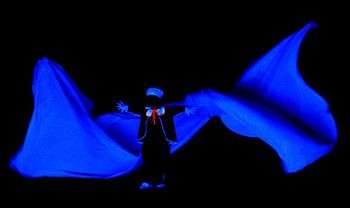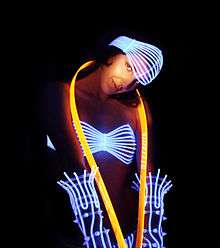Black light theatre
Black Light Theatre (in Czech černé divadlo) or simply Black Theatre, is a theatrical performance style characterized by the use of black box theatre augmented by black light illusion. This form of theatre originated from Asia and can be found in many places around the world. It has become a speciality of Prague, where many theatres use it.[1]
The distinctive characteristics of "black theatre" are the use of black curtains, a darkened stage, and "black lighting" (UV light), paired with fluorescent costumes in order to create intricate visual illusions. This "black cabinet" technique was used by Georges Méliès, and by theatre revolutionary Konstantin Stanislavski (especially in his production of Cain). The technique, paired with the expressive artistry of dance, mime and acrobatics of the performers is able to create remarkable spectacles.[2]
Optics
A key principle of Black Light Theatre is the inability of the human eye to distinguish black objects from a black background. This effect results in effective invisibility for any objects not illuminated by the 'black light'.[2] The second optical principle behind Black Light Theatre is the effect of UV light on fluorescent objects. Black lights actually emit as much light as 'normal' lights, but at a frequency that humans cannot detect. While most objects either absorb UV light or reflect it back at the same frequency at which it came in, fluorescent objects absorb UV light then re-emit it at a longer wavelength that human eyes can detect.[3] The combined effect is that designers can make some objects appear as bright as if the room were fully lighted, while making other objects appear as dark as if the room were completely dark.
History
The 'black box trick' of using performers dressed in black in a dark playing space has been in use for millennia, starting with the jugglers performing for the emperor in ancient China.[4] Japan developed this technique in its Bunraku Theatre by having puppeteers wear black in order to place complete emphasis on the puppet.[5] In modern theatre the black box trick has been adopted up by Russian director Konstantin Stanislavski, film director George Melies, and various French avantgarde directors of the 1950s. Among these directors, George Lafaille became an earlier pioneer of black cabinet.[2] But all these directors used the simple trick of black cabinet just for few moments during their performances mostly to make something on the stage disappear.
The father of modern Black Light Theatre, author of the principe of black cabinet as is used nowadays (placement of spot lights, placement of uv lights, selection of black velvet as the best material to absorb residual light on the scene...) and even author of the name "Black Light Theatre" and so the creator of the 1st Black Light Theatre in the world is Jiri Srnec. The first performance of the ensemble took place in 1959 in Vienna. It became better known after its participation in the Theatre Festival in Edinburgh in 1962. Later, other groups using the technique of black box appeared starting the new wave of this theatre style.[6]
Prague has since become the home of black light theatre with around 10 black light theatre companies .[1][7][8][9][10]
Another well-known group of black light theatre is Black light theatre HILT Prague.,[11] whose performances are based on modern music and dance choreographies, and has incorporated live singing. The group was founded in 2006 by Czech dancer, choreographer, director and music composer Theodor Hoidekr.[12] In 2016 was founded the new black light theatre style called "shadow film theatre" by the group HILT Prague. Except black light theatre shows they present also the first shadow film theatre - dancers and actors are playing with their shadows on the screen with projections of real places.
Modern dance in black theatre
In 1989 the Image Theatre was founded by dancer Eva Asterova (former member of Pavel Smok's famous Czech ballet company) and Alexander Cihar. They brought new aspects into black light theatre effects such as modern dance and non-verbal acting. Under the hand of Eva Asterová, the theatre's artistic director, Image seeks to produce an individual look of at a scene’s signature. The audience also often becomes an integral part of the performance. The repertory of the Image theatre is composed of its own devised works. Apart from Eva Asterová there are also other authors cooperating repeatedly on Image Theatre's performances such as Josef Tichý, Petr Liška, René Pyš or Zdeněk Zdeněk. Since the beginning, Image Theatre had presented 10 different performances [13] and in each of them they came with some new black light technique effects. Magic poetics, playfulness, and humor are the most important trademarks of this ensemble.
The Image theatre has 22 years experience in Prague’s black light theatres scene. Apart from regular performances in Prague, Image also performs internationally (Korea, Hong Hong, Macau, Israel, Turkey, India, Lebanon, Greece, Germany, France, Italy, Switzerland, Belgium, Hungary, Slovakia, Cyprus).
Black Light Theatre today

Nowadays there are many companies of black light theatre also out of Prague (Hungary, Germany,[14] USA) trying to make shows similar to black light theatres in Prague. Prague scene has changed its face to the style of 20th century - modern dance was involved, costume designs have become more effective, black light theatre shows have become more musical. Prague is still home of black light theatre - hundreds thousands of tourists visit their shows every month.
HILT - the black light theatre of Theodor Hoidekr was the first ever who has involved live singing into black light show. The most popular HILT´s black light theatre musical show was "Juliet´s Dream" premiered on 14 February 2012 in Prague. HILT is working on new style of black light theatre - all the members are experienced in black light theatres all over Prague. Its founder and director Theodor Hoidekr was originally dancer who later started to work with black light theatre style. His experiences comes from Prague, Slovakia, Germany, Malta, Greece, South America, India [15]
Since 8 April 2015 HILT performs the new show "Phantom" that is the world first black light theatre version of the mysterious phantom figure. The black light theatre HILT starts the new part of their history in theatre Royal Prague. In 2016 HILT has presented the first shadow film theatre Cinderella.
In 2017 HILT has moved to the Prague popular U Valsu Theatre in the centre of the Old Prague. 2.6.2017 they start to present also their best of called HISTORY 2007 - 2017 that is the combination show of black light theatre and also shadow theatre.
In Performance

The effect of Black Light Theatre allows invisible performers to move visible props, turning the objects into independent participants in the theatre at the same level as the human actors.[2] Furthermore, the appearance of objects and actors in a performance can be sudden and can occur anywhere on stage, even within a few meters of an audience member.[10] In order to achieve this effect it is necessary to create an intense field of UV light throughout the entire playing space. Because the intensity of light emitted from a typical 'black light' source diminishes significantly with increased distance from the source, covering an entire theatre space with UV light requires either that the 'black light' sources be spaced as close as one meter apart or emit much more light than a typical 'black light'.[16] Another important consideration is that, since most of the space is completely dark, and the form is heavily dance based, a single wrong move by a single performer can negatively impact the entire production. For this reason performers train extensively specifically for the Black Light Theatre environment.
Contemporary Black Light Theatre often includes many highly technical devices, in addition to the standard 'black light' technique. Such devices can include "flying" performers, large video projections ,[17] and even massive puppets.[2] These technical devices serve as a significant factor in Black Light Theatre's worldwide popularity; since its most important devices are entirely visual, audiences throughout the world can understand most Black Light Theatre performances.[18] The intended result is a theatrical work that combines grand spectacle with beautiful and moving art.[2] Major companies currently producing Black Light Theatre include Srnec Theatre, HILT, Ta Fantastika Theatre, Image Theatre, Metro Theatre, and All Colours Theatre.[18]
References
- 1 2 http://blacklighttheatre.wbs.cz/tisk-press.html
- 1 2 3 4 5 6 http://www.tafantastika.cz/en/black-light-theatre/index.php#
- ↑ http://van.physics.illinois.edu/qa/listing.php?id=1913
- ↑ http://www.cernedivadlo.cz/theatre.htm
- ↑ http://www.puppetsnow.com/history-of-puppets.html
- ↑ http://www.srnectheatre.com/en/about_us.html
- ↑ http://www.cernedivadlo.cz/festivals-and-awards.htm
- ↑ Image Theatre tours
- ↑ name=tafantastikatour
- 1 2 Badminton Theatre
- ↑ Hilt Theatre Web
- ↑ Times of India
- ↑ Black light Image Theatre: http://www.imagetheatre.cz/en/performance/
- ↑ http://www.velvets-theater.de
- ↑ http://www.hilt-theatre.cz/tisk-press.html
- ↑ http://www.theatrefx.com/funfacts2.html
- ↑ Image Theatre: http://www.imagetheatre.cz/en/afrikania/
- 1 2 http://www.pragueexperience.com/theatre/theatres.asp
External links
- HILT - black light theatre Prague of Theodor Hoidekr
- The first black light and shadow film theatre Prague
- Black Light Theatre Srnec - the 1st Black Light Theatre in the world - since 1961
- Velvets Theater, Wiesbaden, Germany
- IMAGE THEATRE - black light theatre of Prague
- Black Light Theatre World Web
- Black Light Theatre of Prague
- Black light theatre Wow Show Prague
- Black light performance and costumes
- The newest Prague BLT group - Hoidekr Interactive Light Theatre on YouTube.
- Black light theatre page by Google translate in all languages
- Schwarzlichttheater in Konstanz, Schwarzlichttheater in Konstanz
- , ZauberLicht Theater- mobile, international, blacklight theater from Germany